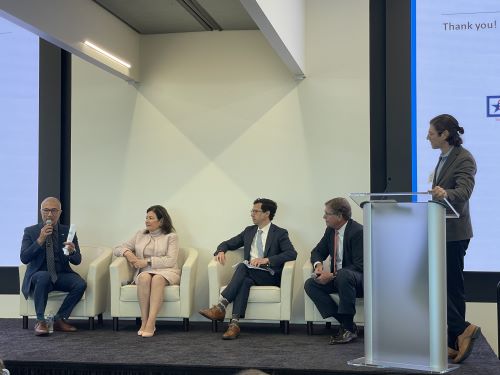The RAISE Act Talking Points Are Deceptive
 Supporters of the RAISE Act are counting on the media, voters, and policy makers to focus on talking points supporting the bill rather than its actual substance. Those supporters want the debate over this bill to be “skilled or merit based immigrants versus family-based immigrants” – a debate that they could win. But they can only do that if everybody focuses on the talking points and they remain ignorant of the actual contents of the bill. The RAISE Act talking points are grossly deceptive, at best, and do not accurately describe the bill’s contents or what its effects would be. Each heading below is a major talking point that RAISE’s supporters are using followed by what the facts actually are.
Supporters of the RAISE Act are counting on the media, voters, and policy makers to focus on talking points supporting the bill rather than its actual substance. Those supporters want the debate over this bill to be “skilled or merit based immigrants versus family-based immigrants” – a debate that they could win. But they can only do that if everybody focuses on the talking points and they remain ignorant of the actual contents of the bill. The RAISE Act talking points are grossly deceptive, at best, and do not accurately describe the bill’s contents or what its effects would be. Each heading below is a major talking point that RAISE’s supporters are using followed by what the facts actually are.
“The RAISE Act creates a merit and skills-based immigration system.”
The RAISE Act does not increase merit and skills-based immigration over the existing cap. The bill sets an annual cap of 140,000 green cards annually for merit and skills-based immigrants – the exact same number apportioned to the current employment-based green card for skilled workers. The RAISE Act merely cuts other immigration categories, such as family-based green cards, while creating a points system for obtaining one of the 140,000 merit and skills-based green cards. Cutting family reunification does not create a merit or skills-based immigration system.
“The RAISE Act is very similar to the merit-based Canadian and Australian immigration systems”
The Canadian and Australian merit-based immigration systems are far more open than either current U.S. immigrant law or what the RAISE Act would create. As a percent of the population, which is the only meaningful way to compare the size of immigrant flows in different countries or across time, the Australian and Canadian merit-based immigration policies allow about 3.5 and 2.4 times as many immigrants annually as the United States, respectively. The RAISE Act would widen this gulf even further whereby the annual immigrant flows to Australia and Canada would be about 7.9 and 5.3 times as great as to the United States.
The comparison is even more lopsided when it comes to skilled immigrants. The annual skilled immigrant flow to the United States under current law (and if the RAISE Act is implemented) is equal to 0.04 percent of the population – and that includes their family members! The workers themselves are only 0.02 percent of the American population. The annual skilled immigrant inflow to Canada is equal to 0.18 percent of their population and in Australia, it is a whopping 0.26 percent – 9 and 13 times as great as in the United States, respectively.
The Canadian and Australian systems even allow more family-based immigrants as an annual percentage of their population at 0.23 and 0.26 percent, respectively, than the United States. In Canada, immigrants are awarded more points if they have distant relatives living there already. The RAISE Act does no such thing.
The Australian and Canadian immigration systems are far more open than the current U.S. immigration and what has been proposed by the RAISE Act. The Australian and Canadian immigration systems have very little in common with what’s proposed by the RAISE Act.
“The RAISE Act will increase wages for working Americans.”
The last time Congress cut legal migration in order to raise the wages of lower-skilled Americans, wage growth actually slowed down. Michael Clemens, Ethan Lewis, and Hannah Postel looked at Congress’ 1964 cancellation of the Bracero program for low-skilled Mexican farm workers discovered that farm worker wages rose more slowly after the migration was cut because farmers turned toward mechanization and planted crops that required less labor. Not only did the supposed wage gains from cutting legal migration not occur after 1964, the rate of wage increase actually slowed.
The details and justifications for the RAISE Act and Congress’ 1964 cancellation of Bracero are eerily similar. The Bracero program allowed in half a million workers a year before it was eliminated – which is roughly the number of green cards that RAISE would cut. Bracero workers have a relatively similar skills level, compared to Americans, of the workers who currently enter of the family-based green cards that the RAISE Act intends to cut. Braceros were also concentrated in some states just like new immigrants are.
More fundamentally, immigration bears little blame for low wages. This point is not controversial among economists who study this issue. The National Academy of Sciences’ (NAS) literature survey on the economic effects of immigration concluded that:
When measured over a period of 10 years or more, the impact of immigration on the wages of native-born workers overall is very small. To the extent that negative impacts occur, they are most likely to be found for prior immigrants or native-born workers who have not completed high school—who are often the closest substitutes for immigrant workers with low skills.
Immigration’s long-run relative wage impact on native-born American workers is close to zero. The only potential exception by education group is high school dropouts who might face more labor market competition from immigration that would produce a maximum relative decline of about 1.7 percent from 1990 to 2010. All groups of native-born Americans by education, which accounts for 91 percent of adults, see relative wage increases from immigration during the same time studied.
Restricting immigration doesn’t raise wages and, even if it did for those Americans who directly compete with immigrants, it would lower wages for the roughly 91 percent of Americans who do not.
“The RAISE Act would restore immigration to historical numerical norms.”
This statement only makes sense if American history began in 1925 – a year after the National Origin Quota Act became law. Because the United States is more populated than it was in the past, the only way to reasonably compare immigrant flows over time is to view the as a percentage of the population. After all, a million immigrants in 1790 would have a far greater impact on the American population than a million immigrants in 2017.
As my colleague David Bier pointed out, the average historical immigration rate from 1820 to 2017 (the government did not count annual immigrant entries before 1820), was 0.45 percent of the U.S. population – higher than the approximately 0.32 percent of today. In other words, current U.S. immigrant flows are actually 29 percent below the historical norms and would have to rise by over 400,000 a year to be them. That’s very different from RAISE’s proposed cut of approximately 500,000 green cards annually.
“Current immigrants are very low skilled.”
New immigrants to the United States are more highly educated than native-born Americans. About 39 percent of immigrants admitted to the United States in 2015 had a college degree or above compared to about 31 percent of adult natives. The share of new immigrants to the United States with at least a college degree is almost double the 21 percent that it was in 1995. About 29.4 percent of all immigrant adults living in the United States in 2015 had a college degree or above, slightly below the 30.8 of all native adults who have the same education. These facts show that new immigrants are more educated than people realize, are increasingly better educated over time, the annual immigrant flow is making the stock of immigrants more educated, and this is happening under the current immigration policy.
“Our current immigration system has increased economic inequality.”
This is an odd argument for Republicans to make but Senior Trump administration aide Stephen Miller did so at a press briefing earlier this week. The evidence on how immigration affects economic inequality in the United States is actually mixed – which is more than you can say about Miller’s other economic invocations where he’s dead wrong. Some research finds relatively small effects of immigration on economic inequality and others find substantial ones. The variance in findings can be explained by different research methods. For instance, outcomes vary considerably between studies that measure how immigration affects economic inequality among only natives and another study that includes immigrants and their earnings. Both methods seem reasonable but the effects on inequality are small compared to other factors. I don’t see the problem if an immigrant quadruples his income by coming to the United States, barely affects the wages of native-born Americans here, and increases economic inequality as a result. The standard of living is much more important than earnings or wealth distribution – especially when the gains are so vast.
“Amnesty for illegal immigrants punishes legal immigrants who got in line and tried to do things the right way. That’s unfair.”
RAISE Act supporters don’t make this argument in support of this specific bill but many of them have in opposition to legalizing illegal immigrants. However, the RAISE Act punishes virtually every wannabe immigrant who is currently in line to get a green card by kicking them out of the running. If RAISE becomes law, it would continue the clear the green card backlog for one year and then cut those who have been in line but didn’t make the cut in the first year. As a meaningless concession, the RAISE Act awards those who are eliminated from the backlog with 2 points under the new points system that requires a total of 20 to get in the new line for another green card. How can RAISE Act supporters complain about the unfairness of an amnesty while supporting this bill?
The RAISE Act says, “you’ve been in line for a green card for 20 years and followed all of the rules? Too bad! You’re out. Here are a few points that will not add up to a green card in compensation.” What kind of message does that send to immigrants who tried to follow the rules the right way?








